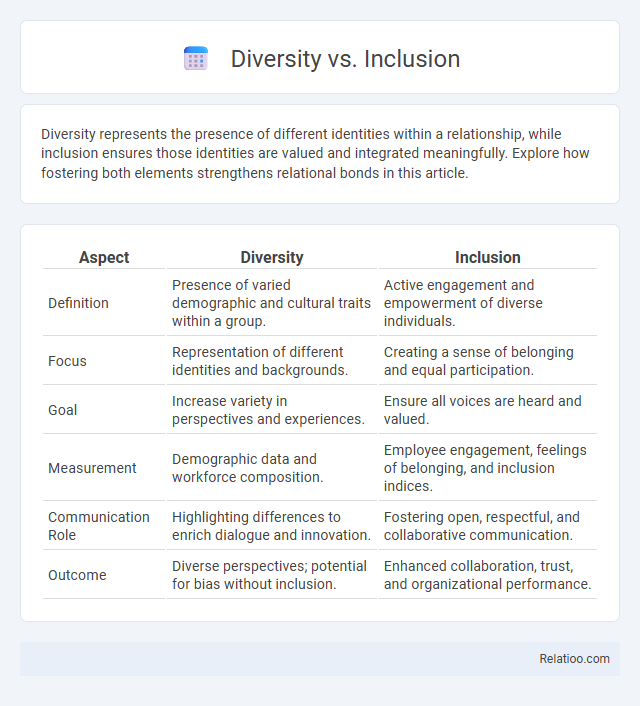Diversity represents the presence of different identities within a relationship, while inclusion ensures those identities are valued and integrated meaningfully. Explore how fostering both elements strengthens relational bonds in this article.
Table of Comparison
| Aspect | Diversity | Inclusion |
|---|---|---|
| Definition | Presence of varied demographic and cultural traits within a group. | Active engagement and empowerment of diverse individuals. |
| Focus | Representation of different identities and backgrounds. | Creating a sense of belonging and equal participation. |
| Goal | Increase variety in perspectives and experiences. | Ensure all voices are heard and valued. |
| Measurement | Demographic data and workforce composition. | Employee engagement, feelings of belonging, and inclusion indices. |
| Communication Role | Highlighting differences to enrich dialogue and innovation. | Fostering open, respectful, and collaborative communication. |
| Outcome | Diverse perspectives; potential for bias without inclusion. | Enhanced collaboration, trust, and organizational performance. |
Understanding Diversity: Defining the Concept
Understanding diversity involves recognizing the range of human differences, including but not limited to race, gender, age, ethnicity, and cultural backgrounds. Your organization benefits when these diverse perspectives are valued and incorporated into team dynamics, fostering innovation and improved decision-making. Defining diversity clearly sets the foundation for effective inclusion and belonging strategies that go beyond mere representation to truly engage and empower every individual.
What Does Inclusion Really Mean?
Inclusion means creating an environment where Your unique perspectives, backgrounds, and experiences are genuinely valued and integrated into decision-making processes. Unlike diversity, which focuses on representation, inclusion emphasizes active participation and equitable access to opportunities for all individuals. True inclusion fosters a sense of belonging, ensuring that everyone feels respected, heard, and empowered within the organization or community.
Key Differences Between Diversity and Inclusion
Diversity refers to the presence of varied demographic characteristics within a group, including race, gender, age, and cultural background, while inclusion is the active effort to create an environment where all individuals feel valued, respected, and able to contribute fully. Your organization can have diversity without inclusion if diverse members are present but not actively engaged or empowered. The key difference lies in diversity being about representation, whereas inclusion focuses on participation and belonging.
The Importance of Diversity in Organizations
Diversity in organizations encompasses the variety of backgrounds, perspectives, and experiences represented within your workforce, driving innovation and adaptability. Inclusion ensures that all individuals feel valued and empowered to contribute fully, while belonging creates a sense of acceptance and connection. Prioritizing diversity enhances organizational performance by fostering creativity, improving problem-solving, and reflecting a broader customer base.
Why Inclusion Matters for Workplace Success
Inclusion fosters a workplace culture where diverse perspectives are valued and employees feel empowered to contribute their unique ideas, driving innovation and collaboration. You benefit from increased employee engagement, higher retention rates, and improved problem-solving when inclusion is prioritized alongside diversity. Embracing inclusion ensures that all team members experience belonging, which is essential for sustainable business success.
Common Misconceptions About Diversity and Inclusion
Common misconceptions about diversity and inclusion confuse diversity as merely counting differences and inclusion as simply inviting diverse people. True diversity encompasses a wide range of identities, experiences, and perspectives, while inclusion ensures that Your contributions are valued, creating a sense of belonging and equitable participation. Understanding these distinctions helps organizations move beyond tokenism toward genuine cultural transformation.
Challenges in Achieving True Diversity and Inclusion
Achieving true diversity and inclusion faces significant challenges such as unconscious bias, resistance to cultural change, and lack of leadership commitment. Organizations often struggle with creating equitable opportunities that go beyond numerical representation to ensure meaningful participation and belonging for underrepresented groups. Overcoming these barriers requires continuous education, transparent policies, and measurable goals to foster an inclusive environment where all individuals thrive.
Strategies for Fostering Diversity vs Inclusion
Effective strategies for fostering diversity focus on implementing targeted recruitment efforts to attract candidates from varied cultural, ethnic, and social backgrounds, alongside establishing unbiased hiring practices. Inclusion strategies emphasize creating an environment where diverse individuals feel valued and empowered through training programs, equitable policies, and active employee resource groups that support collaboration and belonging. Organizations integrating both approaches benefit from enhanced innovation, employee engagement, and overall performance by leveraging diverse perspectives while ensuring every voice is heard and respected.
Measuring the Impact: Diversity vs Inclusion Outcomes
Measuring the impact of diversity focuses on quantifying demographic representation and equitable participation across race, gender, age, and other identity factors within an organization. Inclusion outcomes assess the quality of employee experiences, psychological safety, and belonging, which directly influence engagement, innovation, and retention metrics. Your ability to track both diversity composition and inclusion effectiveness through surveys, turnover rates, and performance data ensures a comprehensive understanding of organizational health and cultural progress.
Building a Culture Where Both Diversity and Inclusion Thrive
Building a culture where both diversity and inclusion thrive requires intentional strategies that go beyond representation, fostering an environment where diverse perspectives are actively valued and empowered. Organizations must implement inclusive leadership practices, equitable policies, and continuous education to eliminate biases and promote belonging for all employees. Measuring inclusion through engagement surveys and diversity metrics helps track progress and ensures sustainable cultural transformation.

Infographic: Diversity vs Inclusion
 relatioo.com
relatioo.com